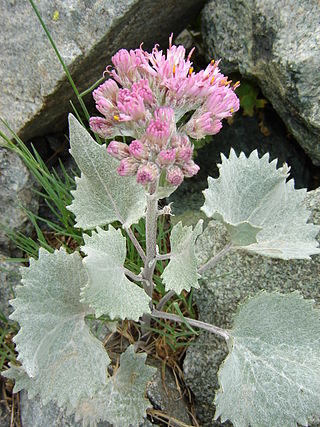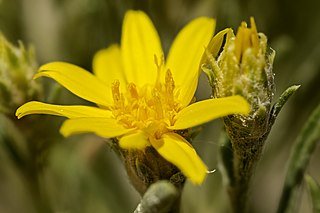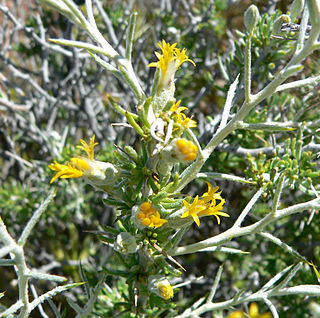
Adenostyles is a genus of flowering plants in the sunflower family Asteraceae, and of the tribe Senecioneae. It was described as a genus in 1816. Adenostyles occur in the temperate climates of the northern hemisphere, mainly in Europe and Asia Minor.

Luina, commonly called silverback, is a small genus of perennial shrubs in the groundsel tribe within the sunflower family.

Monardella is a genus of approximately 40 species of annual and perennial plants native to western North America from British Columbia to northwestern Mexico. They are grown for their highly aromatic foliage, which in some species is used for herbal teas. The two-lipped, tubular flowers are formed in terminal clusters and are most usually red, pink, or purple.

Acourtia is a genus of flowering plants in the family Asteraceae and was first described as a genus in 1830. It includes desertpeonies, such as Acourtia nana and Acourtia runcinata.
Chrysoma is a genus of flowering plants in the family Asteraceae.
Columbiadoria is a small North American genus of flowering plants in the family Asteraceae.

Oonopsis, or false goldenweed, is a genus of flowering plants in the family Asteraceae.
Caucasalia is a genus of flowering plants in the daisy family.
Caxamarca is a genus of flowering plants in the daisy family, Asteraceae.

Chersodoma is a genus of South American flowering plants in the daisy family. Members of this genus or dioecious shrubs or subshrubs.

Dolichoglottis is a genus of flowering plants in the daisy family, Asteraceae.
Gymnodiscus is a genus of South African flowering plants in the sunflower family.

Hasteola is a genus of flowering plants in the daisy family, Asteraceae.

Traversia is a genus of New Zealand plants in the groundsel tribe within the daisy family.
Oligothrix is a genus of flowering plants in the groundsel tribe within the sunflower family.

Tetradymia is a genus of North American shrubs in the groundsel tribe within the sunflower family. Horsebrush is a common name for plants in this genus.
Ligulariopsis is a genus of flowering plants in the groundsel tribe within the sunflower family.

Nemosenecio is a genus of East Asian flowering plants in the groundsel tribe within the sunflower family.
Paracalia is a genus of South American flowering plants in the groundsel tribe within the sunflower family.

Psacalium is a genus of flowering plants in the sunflower family. Indianbush is a common name for Psacalium.












